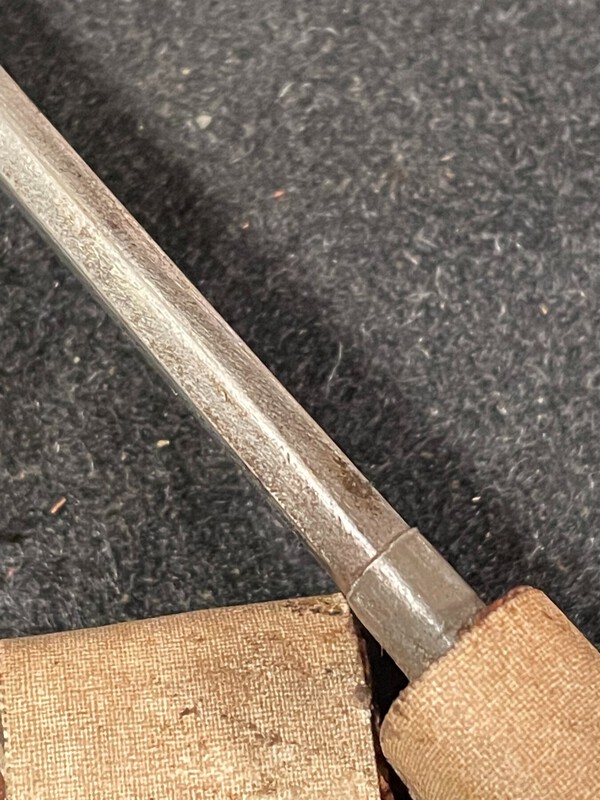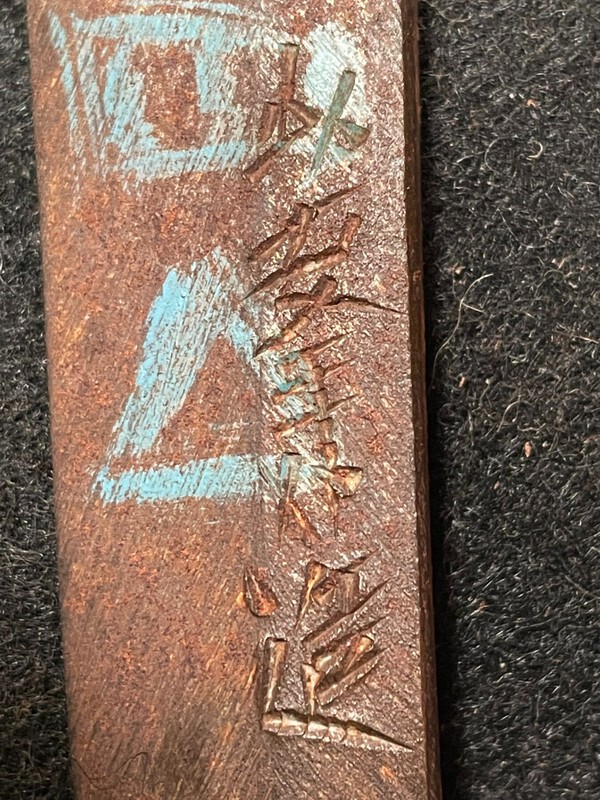
hi-revr
Members-
Posts
25 -
Joined
-
Last visited
-
Days Won
1
Everything posted by hi-revr
-
Thank you for the detailed explanation. There is much to learn not only about the blades but the culture and history. Each time I attempt to research a word or other piece of this puzzle I discover 10 more things to look at. I am grateful so many before have contributed so much.
-
After searching for some time and being really new to all this................I would like to ask a question that seems distantly related to this discusssion. I know the smith is Sukenobu, the last two Kanji. I've seen different translations for Noshu Ju but none convince me they are accurate. What is the literal translation of each Kanji in No Shu Ju ?? What is the generally accepted English translation ??
-
I hoping someone can read the Kanji. It looks like this field made knife had decent rough shaping but little or no real finish work on the blade.
-
Better shot at Star stamp (that one I understand) and circled you can see part of another stamp. Just noticed this one tonight. I assume the Gifu district stamp ?
-
-
Same here No Shu Ju Suke Nobu I understand it roughly translates to Made by SukeNobu but what do the individual Kanji mean? I ask because I want to learn things as correct as possible.
-
-
-
Not really a typo, a newbie mistake. I've spent several hours reading and attempting to learn as much as possible in the past week or so. All of it essentially a foreign language. Like so many things in the collector world, there is a lot of misinformation and outright mistakes. I've been involved in many different hobbies and learned long ago, when starting something new I don't know what I don't know yet. I greatly appreciate everyone's input. As an example of something confusing to a rookie. Yasugi steel ,,,,,, After reading that post last night I spent an hour looking for details and discovered conversations about Yasuki steel. All I know for certain is Yasugi is a city and may or may not be the trade name of a type of steel made there. It looks like ALL the small parts and the wood part of the Tsuka (handle) also have a 9 stamp. Yes you are seeing thin gauge sheet metal between the ray skin and the wood. I have not found anything specifically stating what the number stamps indicate.
-
-
-
-
-
-
I believe this is a standard type 95 but all this is so new I'm not sure yet. To start with here are close ups of the tang stamps. What can you all tell me so far?
-
Here is the piece of silk or cotton that was wrapped around this sword. I would like to know if the English matches the Characters. It looks like he took the time to print the English letters very neat and legible. This was turned in as part of the surrender in Korea it would seem likely this guy survived the war. I also have capture papers for both swords. I did a quick search for the 9th training flight regiment and found nothing. Any further input appreciated.
-
Forgot to answer the screw question. One is flat head the other round head, two different thread pitches. Both look like someone had their 12 year old kid practice grinding one day. threads are 75% gone, both ground to a minor taper.
-
I've collected militaria off and on for 45 years so I know the "buy the item not the story" routine. What got me started was all the stuff my father both sent & brought back during his service from 44-46 most with the 7th division. After landing at Inchon he eventually ended up in the 7th signal company and eventually the 7th signal co supply as supply sergeant(Korea occupation). The most valued thing I own is a shoe box stuffed full of most of the letters he wrote to his parents. It still amazes me how much he either shipped home or packed in his duffle. The items he had and couldn't get home is even more incredible. More on all that in the future. As supply sergeant he would be tasked with requisitioning souvenirs for troops heading home. Contrary to what some believe official orders regarding souvenirs changed several times. By spring/summer 46 as things loosened if a dozen guys were leaving he would go to the depo where all the capture weapons were(a gym at the former Japanese barracks) and get 2 swords, 8-10 rifles, a few helmets, and a handful of bayonets. Needless to say he got to know the guys at the depot and was in a position to help them with regular supply items. He was given two swords and two rifles (one each at different times) from the ""hand picked"" rack behind the desk. He said this one was the only black lacquered scabbard in good shape plus it had a tassel and the best part,,,,,,,,,,,,a silk scarf with what I assume is the original owners information tied to the sword. I will post a pic soon. With all that said I can say with confidence nobody has touched this or the type 95 I will post since 1946. One last tidbit. He coated the blades with Vaseline before shipping them home. He recoated them again back in the late 70's and they still look great.
-
Thanks everyone for the help so far. I'm trying to wade through all the sword lingo and learn. Very interesting but somewhat frustrating being a rookie. I think I get the basic picture of the model and eventually found the warrelics.eu detailed article by Nick Komiya on Rinji seishiki. Here is an interesting piece of that article.............."" """"""Let's start right. It should be written RINJI SEISHIKI GUNTO, not RENJI and pronounced Linji. To be really accurate, the army did not call it anything but a gunto just like the felt field caps had no special name, so they called it descriptively "field caps made of felt". In the same principle, the army did not give the gunto any name, so if you needed to specifically refer to it you had to string adjectives together to describe it. "Rinji Seishiki" was how the Gunto was first described in the memo of 16th September 1938, so using that as an adjective clause, a Japanese would call it a Rinji Seishiki No Gunto, which is merely saying "Gunto designated as contingency specification"."""""" It appears few if any question the majority of what is written in that article. If true these would most accurately be described as {{ Linji Seishiki No Gunto }} of a Type 98. Question.......Why do we say Rinji instead of Linji? Do we know exactly where this blade smith worked? What are the painted charectors? Thanks
-
-
-
-
First time on the site. Looking forward to a lot of reading and learning. I would like to find out as much as possible about this sword and another I will post soon. I feel very lucky to know where both of my swords came from and in the case of this one, who the owner was. This one had not been disassembled until I did it a few days ago. Before someone says DON'T ...............I already cleaned the lose rust off with Hoppe's and a soft brush. There is still plenty of rust. The scabbard is black lacquered wood. It also came with this tassel. The handle wrap looks like a rope material dipped in dark red paint. I'll take some relatively uneducated guesses for fun and see what the experts come back with. I look forward to you confirming or correcting each of my assumptions. }}} I think it was remounted late in the war? }}} Many of the small parts appear mass produced? The Tsuba and spacers have a stamping of 310. }}} The blade appears to be re-drilled for the new handle? The upper hole is somewhat oblong. }}} The green paint characters are either a serial number or the person/company that did the remount? Thanks,

























